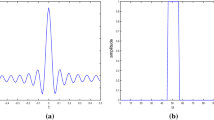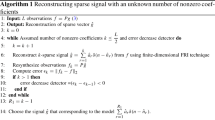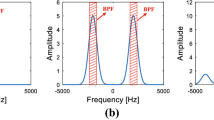Abstract
Finite rate of innovation (FRI) approach is used for sampling and reconstruction of a class of non-bandlimited continuous signals having a finite number of free parameters. Traditionally, Prony and matrix-pencil methods are proposed to reconstruct FRI signals from the discrete samples. However, these methods tend to break down at a certain signal-to-noise ratio (SNR). In this paper, we propose sparsity-based annihilating filter, refer it as sparse-Prony, which avoids polynomial root-finding. In the noiseless scenario, the proposed method is able to recover perfectly the original signal. Simulation results for the noisy scenario demonstrate significant improvement in the performance in terms of MSE over the traditional FRI methods, especially in the breakdown SNR.






Similar content being viewed by others
Availability of data and materials
Not applicable.
References
Vetterli, M., Marziliano, P., Blu, T.: Sampling signals with finite rate of innovation. IEEE Trans. Signal Process. 50(6), 1417–1428 (2002)
Dragotti, P.L., Vetterli, M., Blu, T.: Sampling moments and reconstructing signals of finite rate of innovation: Shannon meets strang-fix. IEEE Trans. Signal Process. 55(5), 1741–1757 (2007)
Blu, T., Dragotti, P.-L., Vetterli, M., Marziliano, P., Coulot, L.: Sparse sampling of signal innovations. IEEE Signal Process. Mag. 25(2), 31–40 (2008)
Urigüen, J.A., Blu, T., Dragotti, P.L.: Fri sampling with arbitrary kernels. IEEE Trans. Signal Process. 61(21), 5310–5323 (2013)
Tur, R., Eldar, Y.C., Friedman, Z.: Innovation rate sampling of pulse streams with application to ultrasound imaging. IEEE Trans. Signal Process. 59(4), 1827–1842 (2011)
Seelamantula, C.S., Mulleti, S.: Super-resolution reconstruction in frequency-domain optical-coherence tomography using the finite-rate-of-innovation principle. IEEE Trans. Signal Process. 62(19), 5020–5029 (2014)
Kusuma, J., Goyal, V.K.: On the accuracy and resolution of powersum-based sampling methods. IEEE Trans. Signal Process. 57(1), 182–193 (2008)
Baechler, G., Freris, N., Quick, R.F., Crochiere, R.E.: Finite rate of innovation based modeling and compression of ECG signals. In: 2013 IEEE International Conference on Acoustics, Speech and Signal Processing, pp. 1252–1256 (2013). IEEE
Deslauriers-Gauthier, S., Marziliano, P.: Magnetic resonance image reconstruction using the annihilating filter method. In: 2011 IEEE International Symposium on Biomedical Imaging: From Nano to Macro, pp. 61–64 (2011). IEEE
Sudhakar Reddy, P., Raghavendra, B.S., Narasimhadhan, A.V.: Magnetic resonance image reconstruction by nullspace based finite rate of innovation framework. In: Proceedings of the Twelfth Indian Conference on Computer Vision, Graphics and Image Processing, pp. 1–5 (2021)
Mulleti, S., Nagesh, S., Langoju, R., Patil, A., Seelamantula, C.S.: Ultrasound image reconstruction using the finite-rate-of-innovation principle. In: 2014 IEEE International Conference on Image Processing (ICIP), pp. 1728–1732 (2014). IEEE
Onativia, J., Schultz, S.R., Dragotti, P.L.: A finite rate of innovation algorithm for fast and accurate spike detection from two-photon calcium imaging. J. Neural Eng. 10(4), 046017 (2013)
Fahmy, M.F., Fahmy, G.: Exponential spline perfect reconstruction, decomposition and reconstruction with applications in compression and denoising. SIViP 8(6), 1111–1120 (2014)
Erdozain, A., Crespo, P.M.: Reconstruction of aperiodic FRI signals and estimation of the rate of innovation based on the state space method. Signal Process. 91(8), 1709–1718 (2011)
Maravic, I., Vetterli, M.: Sampling and reconstruction of signals with finite rate of innovation in the presence of noise. IEEE Trans. Signal Process. 53(8), 2788–2805 (2005)
Leung, V.C., Huang, J.-J., Dragotti, P.L.: Reconstruction of FRI signals using deep neural network approaches. In: ICASSP 2020-2020 IEEE International Conference on Acoustics, Speech and Signal Processing (ICASSP), pp. 5430–5434 (2020). IEEE
Wei, X., Dragotti, P.L.: Guaranteed performance in the FRI setting. IEEE Signal Process. Lett. 22(10), 1661–1665 (2015)
Wei, X., Dragotti, P.L.: Model order selection for sampling FRI signals. In: 2017 IEEE International Conference on Acoustics, Speech and Signal Processing (ICASSP), pp. 4556–4560 (2017). IEEE
Tan, V.Y., Goyal, V.K.: Estimating signals with finite rate of innovation from noisy samples: a stochastic algorithm. IEEE Trans. Signal Process. 56(10), 5135–5146 (2008)
Erdozain, A., Crespo, P.M.: A new stochastic algorithm inspired on genetic algorithms to estimate signals with finite rate of innovation from noisy samples. Signal Process. 90(1), 134–144 (2010)
Wein, A., Srinivasan, L.: Iterml: a fast, robust algorithm for estimating signals with finite rate of innovation. IEEE Trans. Signal Process. 61(21), 5324–5336 (2013)
Najjarzadeh, M., Sadjedi, H.: Reconstruction of finite rate of innovation signals in a noisy scenario: a robust, accurate estimation algorithm. SIViP 14(8), 1707–1715 (2020)
Huang, G., Fu, N., Zhang, J., Qiao, L.: Sparsity-based reconstruction method for signals with finite rate of innovation. In: 2016 IEEE International Conference on Acoustics, Speech and Signal Processing (ICASSP), pp. 4503–4507 (2016). IEEE
Mulleti, S., Seelamantula, C.S.: Periodic non-uniform sampling for FRI signals. In: 2015 IEEE International Conference on Acoustics, Speech and Signal Processing (ICASSP), pp. 5942–5946 (2015). IEEE
Funding
Not applicable.
Author information
Authors and Affiliations
Contributions
All authors contributed to the study conception and design. The first draft of the manuscript was written by P Sudhakar Reddy and all authors commented on previous versions of the manuscript. All authors read and approved the final manuscript.
Corresponding author
Ethics declarations
Conflict of interest
The authors have no relevant financial or non-financial interests to disclose.
Ethical approval
Not applicable.
Additional information
Publisher's Note
Springer Nature remains neutral with regard to jurisdictional claims in published maps and institutional affiliations.
Rights and permissions
Springer Nature or its licensor (e.g. a society or other partner) holds exclusive rights to this article under a publishing agreement with the author(s) or other rightsholder(s); author self-archiving of the accepted manuscript version of this article is solely governed by the terms of such publishing agreement and applicable law.
About this article
Cite this article
Reddy, P.S., Raghavendra, B.S. & Narasimhadhan, A.V. Sparse-Prony FRI signal reconstruction. SIViP 17, 3443–3449 (2023). https://doi.org/10.1007/s11760-023-02566-3
Received:
Revised:
Accepted:
Published:
Issue Date:
DOI: https://doi.org/10.1007/s11760-023-02566-3




